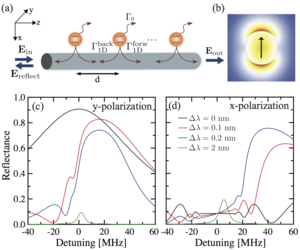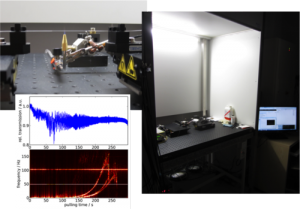NANOFIBER LAB
PEOPLE
Jérémy Raskop (PhD)
Jérémy Berroir (PhD)
Neil Corzo-Trejo (PostDoc)
Alexandra Sheremet (PostDoc)
SOME PUBLICATIONS
Large Bragg reflection from
one-dimensional chains of
trapped atoms near a
nanoscale waveguide (2016)
Phys. Rev. Lett. 117, 133603
Demonstration of a memory
for tightly guided light in an
optical nanofiber (2015)
Phys. Rev. Lett. 114, 180503
Selected as PRL Editors
suggestions, Synopsis in
APS – Physics,
Coverage by and
PhysicsWorld,
French Press release
NANOFIBER LAB

Interfacing guided light with atoms enables long interaction length, large optical depth and non-linear interactions at low power level. Cold atoms are combined here with subwavelength nanofiber for the realization of integrated single-photon sources and quantum memories and the exploration of effects related to one-dimensional lattices.
LARGE BRAGG REFLECTION FROM ONE-DIMENSIONAL CHAINS OF TRAPPED ATOMS
 In this work, we reported experimental observations of large Bragg reflection from arrays of cold atoms trapped near a one-dimensional nanoscale waveguide. By using an optical lattice in the evanescent field surrounding a nanofiber with a period close to commensurate with the resonant wavelength, we observed a reflectance up to 75% for the guided mode. Each atom behaves as a partially-reflecting mirror and an ordered chain of about 2000 atoms is sufficient to realize an efficient Bragg mirror. Measurements of the reflection spectra as a function of the lattice period and the probe polarization are reported. The latter shows the effect of the chiral character of nanoscale waveguides on this reflection. The ability to control photon transport in 1D waveguides coupled to spin systems would allow for novel quantum network capabilities and many-body effects emerging from long-range interactions.
In this work, we reported experimental observations of large Bragg reflection from arrays of cold atoms trapped near a one-dimensional nanoscale waveguide. By using an optical lattice in the evanescent field surrounding a nanofiber with a period close to commensurate with the resonant wavelength, we observed a reflectance up to 75% for the guided mode. Each atom behaves as a partially-reflecting mirror and an ordered chain of about 2000 atoms is sufficient to realize an efficient Bragg mirror. Measurements of the reflection spectra as a function of the lattice period and the probe polarization are reported. The latter shows the effect of the chiral character of nanoscale waveguides on this reflection. The ability to control photon transport in 1D waveguides coupled to spin systems would allow for novel quantum network capabilities and many-body effects emerging from long-range interactions.
The paper: Phys. Rev. Lett. 117, 133603 (2016)
The Focus by APS-Physics: “Strong light reflection from few atoms”
DEMONSTRATION OF A MEMORY FOR TIGHTLY GUIDED LIGHT IN AN OPTICAL NANOFIBER
 In this study, we reported the experimental observation of slow-light and coherent storage in a setting where light is tightly confined in the transverse directions. By interfacing a tapered optical nanofiber with a cold atomic ensemble, we observed electromagnetically induced transparency and light pulses at the single-photon level were stored in and retrieved from the atomic medium with an overall efficiency of 10 %. Collapses and revivals were additionally controlled by an applied magnetic field. We also measured the decay of efficiency with storage time and investigated the concurrent decoherence mechanisms in this system. These results based on subdiffraction-limited optical mode interacting with atoms via the strong evanescent field demonstrate an alternative to free-space focusing and a novel capability for information storage in an all-fibered quantum network.
In this study, we reported the experimental observation of slow-light and coherent storage in a setting where light is tightly confined in the transverse directions. By interfacing a tapered optical nanofiber with a cold atomic ensemble, we observed electromagnetically induced transparency and light pulses at the single-photon level were stored in and retrieved from the atomic medium with an overall efficiency of 10 %. Collapses and revivals were additionally controlled by an applied magnetic field. We also measured the decay of efficiency with storage time and investigated the concurrent decoherence mechanisms in this system. These results based on subdiffraction-limited optical mode interacting with atoms via the strong evanescent field demonstrate an alternative to free-space focusing and a novel capability for information storage in an all-fibered quantum network.
The paper: Physical Review Letters 114, 180503 (2015)
arXiv version
Also featured as PRL editors suggestions and highlighted in APS-Physics and
Physics World .
FIBER PULLING BENCH
 We built a fabrication bench for elongated nanofiber : a standard optical fiber is softened by heating and pulled until its diameter has reached a target value, around half the guided light wavelength. We obtain nanofiber coupled via tapered regions on both sides to the standard fiber. In order to preserve a high transmission, close to unity, and to keep control on the fiber guiding properties, the taper is made with a carefully designed shape. This adiabatic shape is obtained using the flame-brushing technique : the back and forth movement of a clean hydrogen/oxygen flame allows the dynamically change of the effective heating width. Therefore any desired shape can be produced. Real time monitoring is available via imaging, but also via the rich propagation properties of a laser beam guided by the fiber being pulled. The produced nanofiber are further characterized with the SEM facility available in UPMC. In addition to our cold atoms experiment, the fabrication beanch is used by different groups at LKB and UPMC. Our nanofibers are used for instance for collecting light from nanoscale single-photon emitters and they also helped recently to understand the properties of spider silk.
We built a fabrication bench for elongated nanofiber : a standard optical fiber is softened by heating and pulled until its diameter has reached a target value, around half the guided light wavelength. We obtain nanofiber coupled via tapered regions on both sides to the standard fiber. In order to preserve a high transmission, close to unity, and to keep control on the fiber guiding properties, the taper is made with a carefully designed shape. This adiabatic shape is obtained using the flame-brushing technique : the back and forth movement of a clean hydrogen/oxygen flame allows the dynamically change of the effective heating width. Therefore any desired shape can be produced. Real time monitoring is available via imaging, but also via the rich propagation properties of a laser beam guided by the fiber being pulled. The produced nanofiber are further characterized with the SEM facility available in UPMC. In addition to our cold atoms experiment, the fabrication beanch is used by different groups at LKB and UPMC. Our nanofibers are used for instance for collecting light from nanoscale single-photon emitters and they also helped recently to understand the properties of spider silk.
